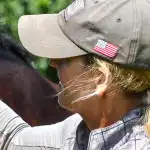
The monster-sized garbage truck was headed straight for the horse I was riding down busy Columbus Avenue, at the height of evening rush hour on New York City’s Upper West Side. Gears grinding loudly, the vehicle kept chugging toward us as I maneuvered my horse as close as possible to the parked cars along the curb in an attempt to avoid a truck-horse-human collision.
The perpetually rearing wooden horse still stares out the enormous picture window oblivious to the constant bustle of New York City, just as he’s done since 1912. All around him, the world has changed. The once plentiful shops offering equestrian accouterments to clients with names like Rockefeller and Kennedy have disappeared, leaving Manhattan Saddlery as the sole surviving tack shop in the borough.
It was 8:45 p.m. on a Thursday evening. It was dark, wet and cold outside. I had 24 hours until the chili cook-off fundraiser I’d been planning for the Area II Young Riders, and the anxiety was setting in, as it always does before any function I plan.
I was doing my best to balance my time between my full-time job at Sinead Halpin Eventing, my part-time job at Prestige Saddles, my commitment to Young Riders, my part-time job teaching at River Edge Farm, and my personal commitment to fitness.
Jayne Fleming, a lifelong horsewoman, died on Aug. 31. She was 80.
Mrs. Fleming’s passion for horses began at a young age; she was 6 when she fell in love with the Welsh ponies she saw at the Royal Winter Fair in Toronto, Ont. Shortly thereafter, her mother gave her a choice of one of three sports: riding, golf or tennis. It was an easy decision for her to choose horses. She began riding with Horace Cunningham at a stable in Ottawa, Ont., breaking horses shipped in from the West.
Gigolo FRH, a six-time Olympic medalist and arguably the most successful dressage horse in history, was euthanized Sept. 23 after he suffered complications from an injury. He was 26.
Gigolo was bred by Horst Kulssmann in 1983. In 1989, Isabell Werth’s then-trainer and sponsor, Uwe Schulten-Baumer, purchased the horse for Werth to ride.
Fuerst Gotthard, a respected sport horse stallion and winner of multiple grand prix jumping competitions, died of age-related issues on Sept. 24. He was 26.
The gray Oldenburg was bred at Gestut Vorwerk, Germany, and imported into the United States as a 3-year-old.
At his Oldenburg licensing, Fuerst Gotthard (First Gotthard—Elisa, Inschallah) scored multiple 8s and was reserve champion of his 100-day test in Culpeper, Va., where he received 9s for ability to work, general jumping ability and cross-country, and an overall score of 132.24 points.
The United States has a problem: the Bureau of Land Management rangeland in the Western states can accommodate about 26,000 wild horses and burros, but there are currently about 32,000 roaming free and 37,000 in pens awaiting adoption. So when you add in the costs of maintaining the horses, in the neighborhood of $25 million annually, the BLM needed to take action.
On Oct. 7, Interior Secretary Ken Salazar proposed a series of initiatives to improve long-term management of the Mustangs and save the taxpayers some money.
The U.S. Equestrian Federation and The EQUUS Foundation have joined together to offer an industry-wide award, which will be presented for the first time during the USEF Pegasus Awards Dinner at the USEF’s annual meeting in January 2010.

By submitting your email, you agree to our Terms of Service and Privacy Policy. You may also receive promotional emails from The Chronicle of the Horse. You can opt out at any time.
For Customers
Company
Terms of Use